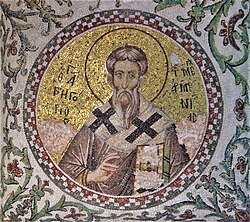Gregory the Illuminator Գրիգոր Լուսաւորիչ | |
|---|---|
 A 14th century Byzantine mosaic of Gregory at the Pammakaristos Church in Constantinople (today Fethiye Camii, Istanbul)[1][2] | |
| Catholicos of All Armenians (Patriarch of Armenia) | |
| Born | 3rd century Kingdom of Armenia |
| Died | c. 328 Daranali, Kingdom of Armenia (present-day Kemah, Erzincan, Turkey) |
| Venerated in | Armenian Apostolic Church Oriental Orthodox Churches Catholic Church Eastern Orthodox Church Anglican Communion |
| Feast | February 20 (Nardò, Italy) March 23 (Anglican Church) Saturday before fourth Sunday after Pentecost (Armenian Apostolic Church – discovery of relics) Last Saturday of Lent (Armenian Apostolic Church – descent into dungeon) Saturday before second Sunday after Pentecost (Armenian Apostolic Church – deliverance from dungeon) September 30 (Eastern Orthodoxy, Oriental Orthodoxy, Catholic Church), October 1 (Catholic Church- 1962 Roman Missal) |
| Patronage | Armenia; Nardò, Italy |
| Part of a series on |
| Oriental Orthodoxy |
|---|
 |
| Oriental Orthodox churches |
|
|
Gregory the Illuminator[a] (Classical Armenian: Գրիգոր Լուսաւորիչ, reformed spelling: Գրիգոր Լուսավորիչ, Grigor Lusavorich;[b] c. 257 – c. 328) was the founder and first official head of the Armenian Apostolic Church.[c] He converted Armenia from Zoroastrianism to Christianity in the early fourth century (traditionally dated to 301), making Armenia the first state to adopt Christianity as its official religion. He is venerated as a saint in the Armenian Apostolic Church and in some other churches.
Gregory is said to have been the son of a Parthian nobleman, Anak, who assassinated the Arsacid king of Armenia Khosrov II. The young Gregory was saved from the extermination of Anak's family and was raised as a Christian in Caesarea of Cappadocia, then part of the Roman Empire. Gregory returned to Armenia as an adult and entered the service of King Tiridates III, who had Gregory tortured after he refused to make a sacrifice to a pagan goddess. After discovering Gregory's true identity, Tiridates had him thrown into a deep pit well called Khor Virap for 14 years. Gregory was miraculously saved from death and released after many years with the help of Tiridates' sister Khosrovidukht. Gregory then converted the King to Christianity, and Armenia then became the first country to adopt Christianity as a state religion in 301 AD. Gregory, the Illuminator, then healed King Tiridates, who the hagiographical sources say had been transfomed into a boar for his sins, and preached Christianity in Armenia. He was consecrated bishop of Armenia at Caesarea, baptized King Tiridates and the Armenian people, and traveled throughout Armenia, destroying pagan temples and building churches in their place.
Gregory eventually gave up the patriarchate to live as a hermit and was succeeded by his son Aristaces. Gregory's descendants, called the Gregorids, hereditarily held the office of Patriarch of Armenia with some interruptions until the fifth century. It is in Gregory's honor that the Armenian Church is sometimes called lusavorchʻakan ("of the Illuminator") or Gregorian.[6]
- ^ Der Nersessian 1966, p. 390.
- ^ Ayvazyan 1984, p. 45.
- ^ "St. Gregory the Enlightener". armenianchurch.us. Eastern Diocese of the Armenian Church of America. Archived from the original on 30 August 2022.
- ^ Schaff, Philip (1867). From Constantine the Great to Gregory the Great, A.D. 311-600, Volume III. New York: Charles Scribner and Company. p. 779.
- ^ Lang 1970, p. 155.
- ^ "Grigor I Lusavorichʻ," Armenian Soviet Encyclopedia 1977.
Cite error: There are <ref group=lower-alpha> tags or {{efn}} templates on this page, but the references will not show without a {{reflist|group=lower-alpha}} template or {{notelist}} template (see the help page).